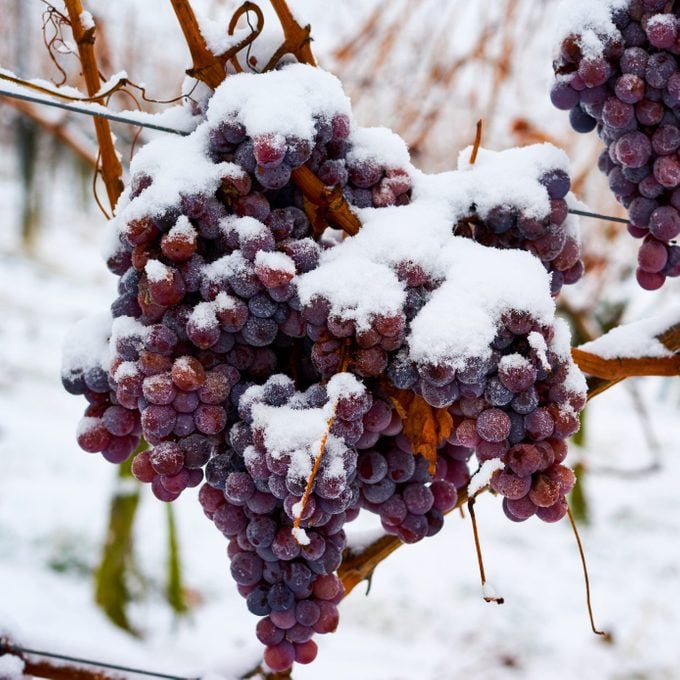Ice Wine: The Ultimate Explainer Guide
Updated: Feb. 13, 2024

Heard about ice wine and are curious to know more? A sommelier explains everything you need to know.
A glass of dessert wine is always welcome at the end of an especially delicious dinner. For folks interested in trying a new style beyond port or Sauternes, allow us to introduce you to ice wine. Made from frozen grapes, ice wine is luxurious. It’s luscious. It’s often expensive, but oh, is it worth it. Plus, it’s a terrific wine to serve during the holidays. It pairs gorgeously with wintry treats like apple desserts and a classic, creamy cheesecake. It lends that extra something to feel more festive. But you can really enjoy ice wine any time of year as a wonderfully versatile drink—and a real treat for your taste buds.
What is ice wine?
Ice wine is a type of sweet dessert wine made from grapes that are frozen while still hanging on the vine. Freezing the grapes separates the water from the sugar-rich grape juice, which makes a decadently sweet wine, unlike anything you’ve ever tasted.
Records suggest that some version of ice wine may date back to the Roman era, but legend has it that the first modern ice wines were created in Franken, Germany. As the story goes, the year was 1794, and an especially harsh winter had settled over the land. Rather than lose the year’s harvest, the clever winemakers used the frozen grapes they had on hand for that vintage, and ice wine was born.
As you might expect from the name, colder climates are a must for making ice wine, so the world’s major ice wine regions lie in countries like Canada, Germany (where it’s known as eiswein) and Austria. Northern parts of the U.S. make fantastic ice wine, too, and you’ll find it produced in many other countries around the globe.
What grapes are used to make ice wine?
Most wineries use white grapes for their ice wines, but you’ll also find some made from red grapes. The best ice wine grapes are hardy against the cold, like riesling, Grüner Veltliner, vidal blanc and gewürztraminer, plus cabernet franc and merlot for the reds.
Taste-wise, ice wine is gloriously sweet with beautifully concentrated flavors. The exact flavors depend on which grape is used, but in general, you can expect intense fruit notes, a palate-refreshing acidity, and plenty of sweetness. Riesling ice wines have tons of juicy peach, apricot and honey, while those made from cabernet franc taste like ripe red berries—think strawberries, cherries and raspberries.
How is ice wine made?

What makes ice wine different compared to other styles is that grape bunches are left to hang on the vine until they freeze. Temperatures must dip down to at least 18°F before this happens. Once frozen, vineyard workers hand-pick the bunches, which are then whisked off to the winery. Here the frozen bunches are pressed to extract the sweet, sweet grape juice. The juice is then fermented, a slower process thanks to the high sugar content. We’re talking a few months to half a year. Ice wines are relatively low alcohol compared to your average wine, hovering around 6 to 10 percent, depending on where they’re made. The final product is a phenomenally sweet, fruity, complex wine that goes with everything from a holiday cheese plate to a spicy Indian curry.
Why is ice wine so expensive?
Looking at the price tag on most ice wines might be a bit shocking, but there’s a simple reason why bottles will set you back a good few dollars: Producing ice wine is an expensive affair. Everything is done by hand, from farming to harvesting the grapes. Winemakers need more grapes to make ice wine, but because the grapes are frozen, there’s much less juice to work with compared to your standard table wines.
It’s a risky business as well. If the grapes freeze too hard, they won’t release any juice. And, of course, the longer the bunches are left on the vine, the higher the risk of rot and hungry animals dropping by for a snack.
Where to Buy Ice Wine

Never tried ice wine before? Aldi recently released its Specialty Collection ice wine, which has the incredibly wallet-friendly price of $15—stellar for anyone looking for an affordable intro to ice wine. Most other ice wines will set you back around $60 or so, with some bottles getting up into the hundreds. You can find ice wine at your local wine shops as well as online retailers like Drizly. Inniskillen is Canada’s most famous ice wine producer, and if you want to head to Germany, check out Dr. Loosen. Peller Estates makes a wickedly delicious cabernet franc ice wine.
What’s the best way to enjoy ice wine?
Ice wine tastes best chilled—aim for around 46° to 50°. Pop the bottle in your fridge for an hour or two before you plan on serving the ice wine, and you’ll be as golden as the elixir in your glass. Speaking of glasses, the ideal glass for ice wine is a tulip glass. No tulips? No problem. A standard white wine glass will do the trick.
Pair ice wine with cheesecakes, crème brûlée, panna cotta, or apple or pear desserts (a pear tart with ice wine is divine). That said, you don’t need to stick with sweets. Ice wine pairs quite well with salty and spicy dishes. Thai curries, tacos, pizza and cheese are knockout dishes with a glass of ice wine to wash everything down.
